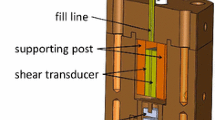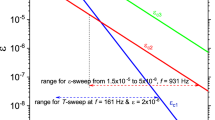Abstract
The large zero-point motion and rapid atomic exchange in quantum solids like helium make defects extremely mobile. Previous shear modulus measurements have shown that mobile dislocations can soften the shear modulus of high purity hcp \(^4\)He by as much as 90%, and that isotopic impurities (\(^3\)He atoms) pin dislocations and restore the intrinsic shear modulus at low temperatures. In this paper, we report shear modulus and dissipation measurements on solid \(^3\)He in its body-centred cubic (bcc) phase. The lighter mass makes \(^3\)He an even more quantum solid, with much higher exchange frequencies, but its spin and different crystal structure can change the nature of dislocations and their behavior. Our measurements show that the shear modulus of bcc \(^3\)He had many similarities to that of hcp \(^4\)He, including a thermally activated transition from a stiff state to a soft state as \(^4\)He impurities unbind from dislocations when the temperature increases. The impurity binding energies are smaller than those in hcp \(^4\)He and depend more strongly on pressure than a simple elastic binding model would suggest. In contrast to hcp \(^4\)He, the shear modulus of bcc \(^3\)He continues to decrease at temperatures up to 1 K, accompanied by a second dissipation peak with a larger activation energy. This behavior suggests that dislocation motion may be limited by intersections in tangled network in bcc \(^3\)He but can overcome these barriers at high temperatures by thermal activation.






Similar content being viewed by others
References
A. Andreev, I. Lifshits, Zhur. Eksper. Teoret. Fiziki 56(6), 2057 (1969)
A.J. Leggett, Phys. Rev. Lett. 25(22), 1543 (1970)
Z.G. Cheng, J. Beamish, Phys. Rev. B 95(18), 180103 (2017)
J.T. West, O. Syshchenko, J. Beamish, M.H. Chan, Nat. Phys. 5(8), 598 (2009)
Z.G. Cheng, F. Souris, J. Beamish, J. Low Temp. Phys. 183(3–4), 99 (2016)
J. Beamish, S. Balibar, Rev. Mod. Phys. 92(4), 045002 (2020)
J. Day, J. Beamish, Nature 450(7171), 853 (2007)
A. Haziot, A.D. Fefferman, F. Souris, J.R. Beamish, H.J. Maris, S. Balibar, Phys. Rev. B 88(1), 014106 (2013)
A. Haziot, X. Rojas, A.D. Fefferman, J.R. Beamish, S. Balibar, Phys. Rev. Lett. 110(3), 035301 (2013)
A. Haziot, A.D. Fefferman, J.R. Beamish, S. Balibar, Phys. Rev. B 87(6), 060509 (2013)
J. Beamish, J. Franck, Phys. Rev. B 26(11), 6104 (1982)
J. Day, O. Syshchenko, J. Beamish, Phys. Rev. Lett. 104(7), 075302 (2010)
E.S. Kang, D.Y. Kim, H.C. Kim, E. Kim, Phys. Rev. B 87(9), 094512 (2013)
A. Fefferman, F. Souris, A. Haziot, J. Beamish, S. Balibar, Phys. Rev. B 89(1), 014105 (2014)
F. Souris, A.D. Fefferman, H.J. Maris, V. Dauvois, P. Jean-Baptiste, J.R. Beamish, S. Balibar, Phys. Rev. B 90(18), 180103 (2014)
D. Greywall, Phys. Rev. B 11(3), 1070 (1975)
I. Iwasa, H. Suzuki, J. Phys. Soc. Jpn. 49(5), 1722 (1980)
G.N. Greaves, A.L. Greer, R.S. Lakes, T. Rouxel, Nat. Mater. 10(11), 823 (2011)
M. Boninsegni, A. Kuklov, L. Pollet, N. Prokof’ev, B. Svistunov, M. Troyer, Phys. Rev. Lett. 99(3), 035301 (2007)
A. Kuklov, L. Pollet, N. Prokof’ev, B. Svistunov, Phys. Rev. B 90(18), 184508 (2014)
S. Heald, D. Baer, R. Simmons, Solid State Commun. 47(10), 807 (1983)
R. Guyer, R. Richardson, L. Zane, Rev. Mod. Phys. 43(4), 532 (1971)
Z.G. Cheng, J. Beamish, Phys. Rev. Lett. 121(5), 055301 (2018)
J. Beamish, J. Low Temp. Phys. 197, 187 (2019)
R.H. Crepeau, O. Heybey, D. Lee, S.A. Strauss, Phys. Rev. A 3(3), 1162 (1971)
S. Kiselev, V. Khmelenko, D. Geller, D. Lee, J. Beamish, J. Low Temp. Phys. 119(3), 357 (2000)
E. Kim, M.H. Chan, Science 305(5692), 1941 (2004)
J. Beamish, A. Fefferman, A. Haziot, X. Rojas, S. Balibar, Phys. Rev. B 85(18), 180501 (2012)
D. Bishop, M. Paalanen, J. Reppy, Phys. Rev. B 24(5), 2844 (1981)
A. Eyal, X. Mi, A.V. Talanov, J.D. Reppy, Proc. Natl. Acad. Sci. 113(23), E3203 (2016)
Acknowledgements
One of the authors (JB) began his Ph.D. research soon after ultrasonic measurements on solid helium first showed the importance of dislocations in \(^4\)He crystals. Before beginning experiments on helium crystals, he was told to read the existing literature in the field, which led straight to the papers of John Reppy and David Lee. In addition to their famous 1970s work on liquid \(^3\)He and helium films, they and their students had done pioneering experiments on solid helium. An early tour de force experiment by David Lee’s group [25] used optical and ultrasonic techniques to orient hcp \(^4\)He crystals and measure their elastic constants. They were able to determine all five of its elastic constants, the most complete and accurate set of its elastic constants available to this day. Much later, JB had the pleasure of working directly with Dave and his group during a sabbatical at Cornell [26]. Anyone studying solid \(^4\)He in the 1970s was tantalized by the possibility of supersolidity. The idea that a quantum solid could simultaneously have crystalline and superfluid order had been suggested theoretically but there was no convincing experimental evidence until Kim and Chan’s 2004 torsional oscillator experiment [27]. Solid helium was a very active research field over the following decade but eventually it became clear that the torsional oscillator effects were due to elastic effects of dislocations, rather than mass decoupling of a superfluid component [28]. John Reppy’s early development of high Q torsional oscillators was the basis for most of the work in this field. His 1981 torsional oscillator measurement with solid \(^4\)He showed no evidence of supersolidity [29], which was probably the main reason for a hiatus in research on solid \(^4\)He over the next two decades. A decade after Kim and Chan’s 2004 paper, John Reppy’s original conclusion has been confirmed, in large part through his own innovative torsional oscillator experiments [30]. Throughout his career, when JB turned to new areas of research—helium films, porous media, supersolidity—he found that John Reppy had been there first. Characteristically, John had used his intuition for the crucial issues and his ability to develop and apply new techniques to do landmark experiments. JB’s decision in 2004, to focus on flow and elasticity in solid helium, reflected a practical recognition that he wasn’t likely to match John Reppy and his scientific descendents’ torsional oscillator expertise, so had better focus on other measurements. It was a good decision. One of the great pleasures of JB’s “helium physics” life has been the opportunities it provided to meet and discuss helium physics with John. The other author of this paper (ZGC) received his training in helium physics at Penn State University under the supervision of Moses Chan, who had been a graduate student of John Reppy. He joined the Penn State group in 2006, at the beginning of “supersolid” decade, so the first experimental device he used was the torsional oscillator. As a first year graduate student, he machined one on a lathe, carefully attached electrodes and wirings, mounted it on the dilution fridge, and cooled it down. He was fascinated when he phase-locked the resonance with a Q of one million, and saw the beautiful superfluid transition in liquid helium. He could not fully express his admiration to the inventor of this technique—his “scientific grandfather”, but he knew this is the research he would like to do. As time went by, he had more chances to communicate with John Reppy face to face, and always enjoyed those enlightening conversations although he was the listener for most of the time. He has now started his own research group in China, not only continuing helium research, but also taking the legacy of scientific and critical thinking from John and Moses, and passing it to younger students.
Funding
This research was supported by funding from NSERC Canada, and from the Key Research Program of Frontier Sciences, CAS, Grant No. ZDBS-LY-SLH001, National Key R&D Program of China Grant No. 2018YFA0305604 and the National Science Foundation of China (NSFC) Grant No. 11874403.
Author information
Authors and Affiliations
Corresponding author
Additional information
Publisher's Note
Springer Nature remains neutral with regard to jurisdictional claims in published maps and institutional affiliations.
Rights and permissions
About this article
Cite this article
Cheng, Z.G., Beamish, J. Shear Modulus and Dislocation Effects in bcc \(^3\)He. J Low Temp Phys 205, 263–278 (2021). https://doi.org/10.1007/s10909-021-02635-2
Received:
Accepted:
Published:
Issue Date:
DOI: https://doi.org/10.1007/s10909-021-02635-2




